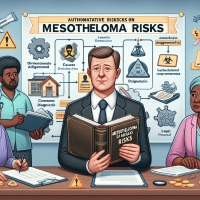Mesothelioma Cancer: Asbestos Exposure Risks Revealed
Mesothelioma is a rare, aggressive cancer primarily linked to asbestos exposure. In this in-depth guide, we explore the intricate relationship between asbestos exposure risks and mesothelioma cancer, offering actionable insights, practical strategies, and robust tools to empower decision-makers in the field. Whether you are a trader, analyst, or a firm owner navigating this challenging landscape, this post will equip you with clear steps and proven resources to combat risks and drive informed decisions.

Understanding Asbestos Exposure Risks and Mesothelioma
Asbestos, a naturally occurring mineral once widely used for its insulation and fire-resistant properties, poses significant health hazards when its fibers become airborne. Prolonged or intense exposure to asbestos fibers can lead to mesothelioma—a cancer that affects the lining of the lungs, abdomen, or heart, and is often diagnosed only after reaching an advanced stage.
The primary search phrase “Asbestos exposure risks” underscores the urgency to understand and mitigate exposure. In this post, we will explore:
- The mechanics of asbestos fiber inhalation and its progression to mesothelioma
- Prevention strategies including asbestos removal, testing, and abatement
- Tools and best practices for analyzing and managing related risks
Asbestos Exposure: From Hazard to Health Crisis
Exposure to asbestos can happen in various environments, from older industrial sites to residential buildings constructed before strict regulations were enforced. Even minimal exposure may have long-term health implications, and understanding these risks is paramount for both prevention and management.
The Science Behind Asbestos-Related Mesothelioma
When asbestos fibers are inhaled, they can lodge in the pleura (the lining of the lungs) and eventually cause inflammation and scarring. Over years, these fibers may trigger cellular mutations leading to mesothelioma. Key factors include:
- Duration of Exposure: Longer exposure increases the likelihood of mesothelioma developing.
- Concentration of Fibers: High levels of airborne fibers, often found in industrial settings or poorly maintained buildings, pose greater risks.
- Individual Susceptibility: Genetics and pre-existing respiratory conditions can exacerbate the risks associated with asbestos exposure.
Prevention Tactics: From Asbestos Testing to Abatement
In order to reduce the risks associated with asbestos exposure, executing thorough removal, inspection, testing, and abatement is essential. Here’s a closer look at some of the most critical steps:
1. Asbestos Testing and Inspection
Before any removal work can be performed, rigorous asbestos testing is necessary. Professionals from accredited labs or testing companies (such as ALS Global or Eurofins Scientific) typically conduct inspections to identify the presence and concentration of asbestos fibers. This is a crucial step in risk mitigation.
2. Asbestos Removal and Remediation
When asbestos is detected, safe removal and remediation become a priority. Given the dangers of improper handling, hiring a certified asbestos removal company is vital. These companies specialize in both asbestos removal and abatement, ensuring that contaminated materials are disposed of safely. Recent market solutions include competitive pricing like asbestos removal cost evaluations, along with localized services found via searches such as asbestos removal near me or asbestos testing near me.
3. Abatement and Post-Removal Practices
Abatement isn’t just about removal—it’s also about preventing future exposure. Regular property inspections, updates in safety protocols, and ongoing environmental monitoring are essential to ensure that debris or residual contamination does not pose a renewed risk.
Tool Recommendations for In-Depth Analysis
Decision-makers in the mesothelioma cancer sector often require precise data analytics and operational tools to monitor and manage these risks effectively. Below are some practical, real-world recommendations:
Data Analytics Platforms
For comprehensive data analysis and visualization, platforms like Tableau offer robust features for trend analysis and risk storytelling. Tableau’s intuitive dashboard assists organizations in mapping out asbestos test results, identifying high-risk zones, and optimizing resource allocation. Another effective tool, IBM Watson Health, leverages AI to predict potential risk areas and track evolving exposure conditions.
Project Management and Compliance Tools
Ensuring compliance with environmental standards is crucial. Tools such as SAS and Microsoft Power BI help in maintaining regulatory records, tracking remediation progress, and managing the logistics of asbestos removal projects. These platforms not only simplify documentation but also enhance transparency in the abatement process.
Real-World Example: Comparing Asbestos Removal Companies
Below is a sample table that compares key parameters for popular asbestos removal services:
| Service | Average Cost | Local Rating | Service Area |
|---|---|---|---|
| SafeClean Remediation | $3,500 | 4.6/5 | National |
| Elite Asbestos Removal | $4,200 | 4.8/5 | Regional |
| EcoSafe Abatement | $3,900 | 4.5/5 | Local |
This table not only highlights cost comparisons but also emphasizes service quality which is critical in hazardous conditions involving asbestos exposure risks. Decision-makers can use such data to negotiate contracts and choose services that best match their operational needs.
Actionable Steps to Mitigate Asbestos Exposure Risks
Implementing effective strategies to mitigate asbestos risks requires a systematic approach. Follow this step-by-step guide to protect your environment and minimize mesothelioma cancer risks:
Step 1: Conduct a Detailed Assessment
Start by performing a comprehensive asbestos inspection. Engage professionals to assess your property, focusing on areas where asbestos is most likely to be present. Remember, proper asbestos testing may involve both visual inspections and laboratory analysis.
Step 2: Analyze Data and Map High-Risk Zones
Utilize data analytics tools such as Tableau or IBM Watson to aggregate inspection data. Build heat maps that illustrate hotspots of asbestos presence, ensuring that remediation efforts are targeted and efficient.
Step 3: Engage a Certified Asbestos Removal Company
Once high-risk areas have been identified, hire a reputable asbestos removal company for safe abatement. Check reviews, verify certifications, and examine past projects to make an informed decision. Keywords like asbestos removal company and asbestos abatement cost can guide your research.
Step 4: Implement Ongoing Monitoring and Maintenance
After removal, sustained vigilance is necessary. Schedule periodic inspections and maintain documentation of all remediation efforts. Continuous tracking helps prevent direct re-exposure and ensures compliance with health regulations.
Internal Resources and Further Reading
For further insights into mesothelioma-related topics, consider reading our detailed articles on Understanding Mesothelioma Treatments and Research and Mesothelioma Legal and Support Resources. These resources provide additional technical detail and personal case studies that can help round out your understanding of both the health and procedural dimensions of asbestos exposure risks.
Key Takeaways
An in-depth understanding of asbestos exposure risks is critical for mitigating the progression to mesothelioma cancer. By combining rigorous testing, effective removal strategies, and advanced data analytics, organizations can safely manage and eventually reduce the threat posed by asbestos. Whether you are making high-level decisions or implementing frontline safety protocols, these actionable insights and practical tools are designed to serve as your roadmap to success.
By following the steps outlined above and leveraging advanced platforms such as Tableau, IBM Watson Health, SAS, and Microsoft Power BI, you can ensure that your asbestos risk management strategy not only meets current compliance standards but also sets a new benchmark for safety and efficiency in the mesothelioma cancer industry.
Call to Action
Ready to take your asbestos exposure risk management to the next level? Download our comprehensive checklist and sign up for our upcoming webinar on innovative mesothelioma risk mitigation strategies. Stay informed, stay safe, and play a proactive role in reducing the menace of asbestos exposure in your community.






